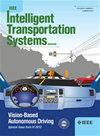基于时间层次图模型的优化多车动态路线规划
IF 5
3区 工程技术
Q1 ENGINEERING, ELECTRICAL & ELECTRONIC
IEEE Intelligent Transportation Systems Magazine
Pub Date : 2023-11-01
DOI:10.1109/mits.2023.3302330
引用次数: 0
摘要
本文章由计算机程序翻译,如有差异,请以英文原文为准。
Optimized Multicar Dynamic Route Planning Based on Time-Hierarchical Graph Model
Traffic congestion has become a major concern in most cities all over the world. The proper guidance of cars with an effective route planning method has become a fundamental and smart way to alleviate congestion under existing urban road facilities. Current route planning methods mainly focus on a single car, but ignoring the dynamic effect between cars may lead to severe congestion during the actual driving guidance. In this article, we extend the study of route planning to the case of multiple cars and present a novel multicar shortest travel-time routing problem. The objective is to minimize the average travel time by considering the dynamic effect of the induced traffic congestion on travel speed, while ensuring that each car’s travel distance is within an acceptable range. We construct a time-hierarchical graph model for structuring the spatiotemporal dynamic properties of the urban road network and then develop a two-level multicar route planning optimization method for complex problem solving. The experimental results show that our path recommendations reduce the average travel time by 51.74% and 38.87% on average compared to two representative methods. Our research will become more important in the years ahead as self-driving cars become more commonplace.
求助全文
通过发布文献求助,成功后即可免费获取论文全文。
去求助
来源期刊

IEEE Intelligent Transportation Systems Magazine
ENGINEERING, ELECTRICAL & ELECTRONIC-TRANSPORTATION SCIENCE & TECHNOLOGY
CiteScore
8.00
自引率
8.30%
发文量
147
期刊介绍:
The IEEE Intelligent Transportation Systems Magazine (ITSM) publishes peer-reviewed articles that provide innovative research ideas and application results, report significant application case studies, and raise awareness of pressing research and application challenges in all areas of intelligent transportation systems. In contrast to the highly academic publication of the IEEE Transactions on Intelligent Transportation Systems, the ITS Magazine focuses on providing needed information to all members of IEEE ITS society, serving as a dissemination vehicle for ITS Society members and the others to learn the state of the art development and progress on ITS research and applications. High quality tutorials, surveys, successful implementations, technology reviews, lessons learned, policy and societal impacts, and ITS educational issues are published as well. The ITS Magazine also serves as an ideal media communication vehicle between the governing body of ITS society and its membership and promotes ITS community development and growth.
 求助内容:
求助内容: 应助结果提醒方式:
应助结果提醒方式:


